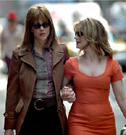
Movie Guru Rating:

Comment
on this review
| |

In the Cut could use a little more articulation
by Coury Turczyn
The New York City of director Jane Campion's In the Cut is an urban graveyard where shadows lurk in broad daylight. Every crowded street corner, alleyway, or subway station appears ready to burst into a bloody scene of misogynistic violence. Out of the blurred corners of the camera's view, women dart past as if evading pursuers, burly men look ready to attack their mates—and was that a scream? The fact that there's a serial killer afoot "disarticulating" women into small pieces and stuffing them into Laundromat washing machines doesn't seem to surprise anybody. This is a place where everyone appears resigned to his or her fate.
Sounds like a prime setting for a modern film noir told from a feminine perspective, you might think. In fact, that's a fresh idea: Take the usual noir trappings of an unforgiving metropolis and its brutal crimes, and then make your disaffected anti-hero a woman. This could allow for all sorts of new spins on an old genre.
Too bad, then, that Campion disarticulates In the Cut with so many absurdities that the film's pieces never cohere in the first place. Murder thriller? Noir detective tale? Art-house meditation on human longing? None of those movies take precedence in a script that undercuts whichever story it's trying to tell with unintended silliness. Campion may have an intuitive feel for injecting a woman's perspective into film, but she sure as heck doesn't know how to tell a murder story.
The first troubling sign of narrative discombobulation appears within the first 10 minutes, in a scene that's supposed to set up the film's central mystery. First, we meet Franny Thorstin (Meg Ryan), a repressed Manhattan high school teacher, as she starts her day. The first thing she does upon leaving her apartment is meet with a student that she's tutoring—at a bar. This is one of those bars that's filled with thirtysomethings drinking and playing pool at seven or eight in the morning.
First question: Why does she take a teenager to a bar to talk about his English assignment? OK—maybe she's so jaded she's stupid. Second question: Do people really party that early? These aren't winos, after all. Uh, maybe it's not really the morning, then. But after this scene, we see her teaching classes, so it must be in the morning, right? Well, um, later she tells the police she was at the bar at 3:30 in the afternoon. Yeah, but the police officers say that she was there at night, according to her credit receipt—even though the scene itself clearly showed daylight outside the windows. Ohhhh, my head aches, and we're not even to the big mystery yet.
All right, never mind—let's put aside all those incongruities and concentrate on the murder stuff. While at the bar, Franny goes to the rest room in the basement and sees a shadowy figure of a man receiving oral sex from a woman. The only identifying details she witnesses are, amazingly, a small tattoo on the inside of the man's wrist and the woman's purple fingernail polish. Cut to the next day: A woman from that bar with purple fingernail polish has been hacked to bits—and the cop sent to interview Franny has the very same tattoo! Naturally, she falls for Detective Malloy (Mark Ruffalo) even as she has troubling doubts about his being a homicidal maniac.
Now we come to the part of In the Cut that its vexed marketers no doubt latched onto with relief: Meg Ryan—our nation's sweetheart of long standing—has sex! But of all the elements in the movie that don't work, the sexual dynamics here are actually the most convincing. Ryan's Franny is so world-weary, so consumed by ennui, that sex with a possible killer seems like her best option for coming back to life. Love, romance, or offspring are not on her "to-do" list because she doesn't believe they're possibilities, however remote. But sex is something that's attainable. Ryan ably conveys this tired cynicism without becoming a total drip, ultimately creating a movie character that's a rarity: a woman with an actual sexual appetite outside of marital yearning. Watching Franny allow herself to become ensnared by Malloy's blunt flirtations compose In the Cut's most compelling scenes.
Inevitably, however, we return to the script's silliness. Any time directors or screenwriters force their otherwise smart characters to act really stupid in order to keep the story moving forward, you've got an annoying cinema experience. Prime example: After Franny becomes involved with the possibly psychotic Detective Malloy, she reveals the fact that she suspects he's the killer. Does our ace homicide detective ask her why? Oh no, no—he just shrugs and mumbles a few times that she needs to make a statement down at the police station. This is because if she actually did explain why she suspected him, the identity of the killer would be instantaneously revealed. And even if Malloy were in fact the killer, wouldn't he want to ask what the one possible witness knows? Apparently not.
Campion manages to keep the mystery afloat for a while simply by virtue of making every male character thuggish. In the world of In the Cut, every man is either a brute or a creep (or a combination of both). From a feminine viewpoint, I suppose this makes the film more harrowing—confirming suspicions that every man is capable of violent misogyny—but it's also off-putting. In classic noirs, all the characters may possibly be evil or corrupt, but they're interesting.
With In the Cut, you just want to edge away from every skeezy guy in the movie, and you wonder why Franny doesn't eventually get a clue. Unfortunately, In the Cut isn't that kind of mystery.
Coury Turczyn is the editor of PopCult Magazine.

November 6, 2003 * Vol. 13, No. 45
© 2000 Metro Pulse
|





